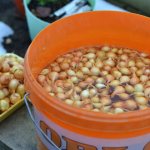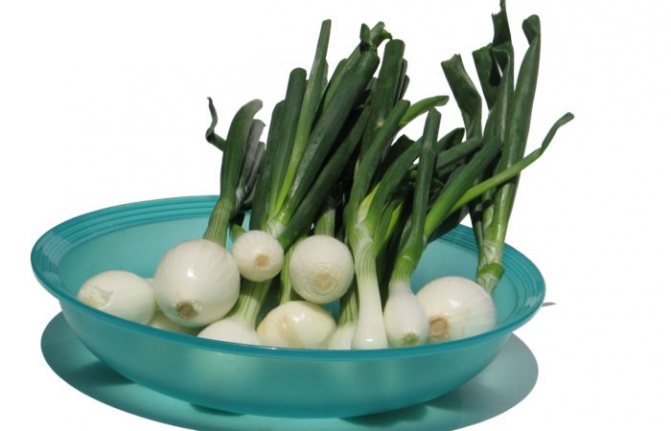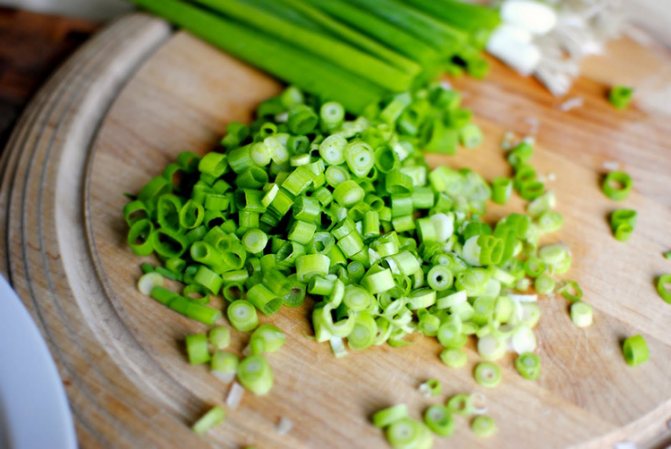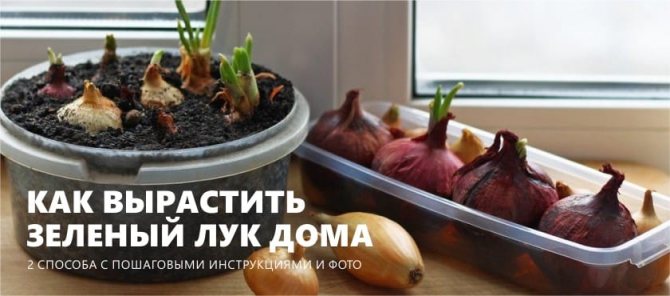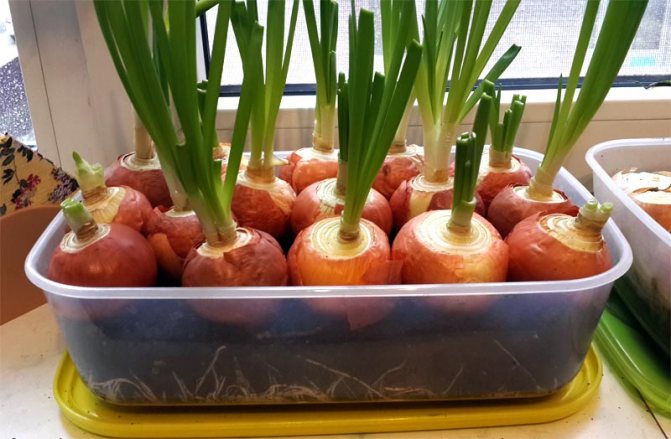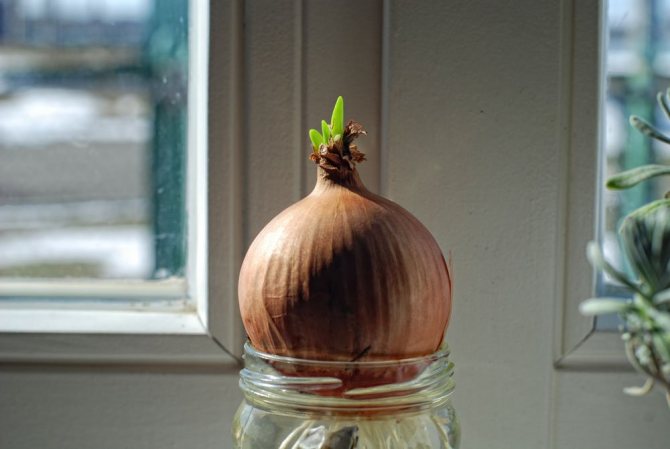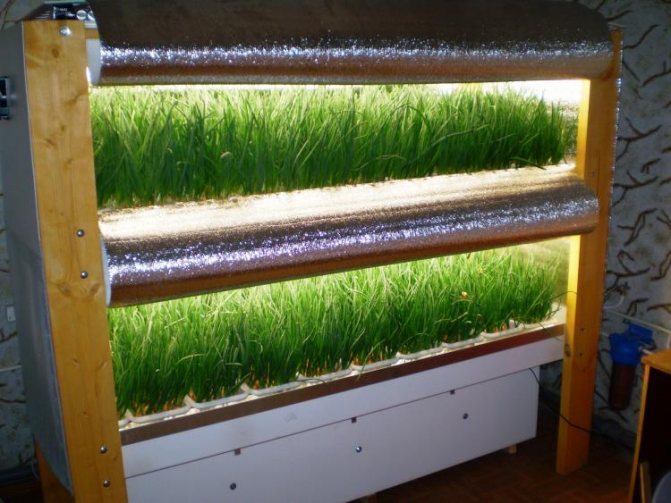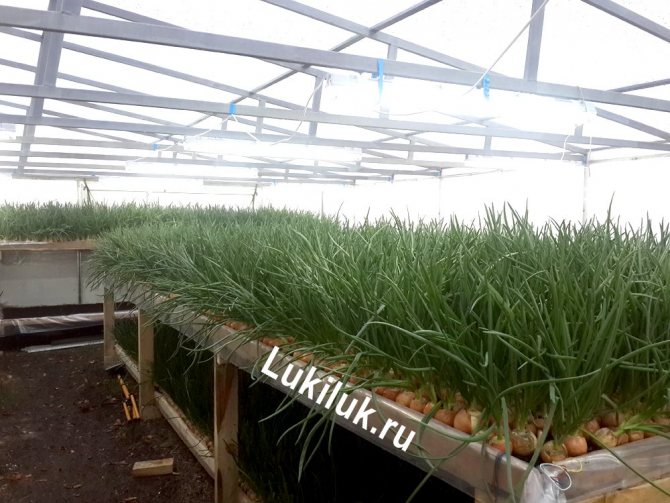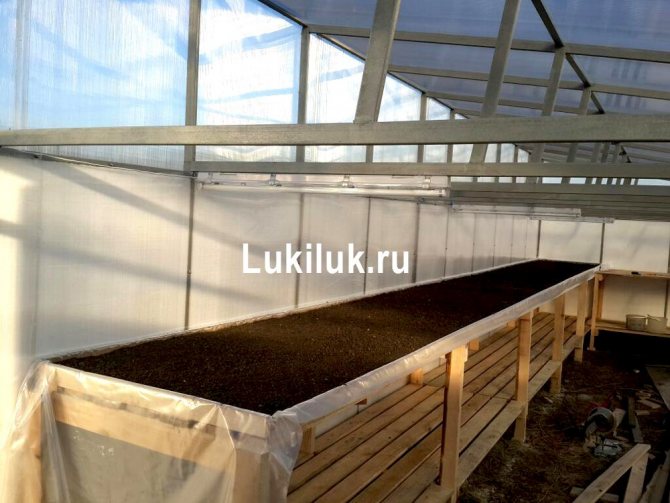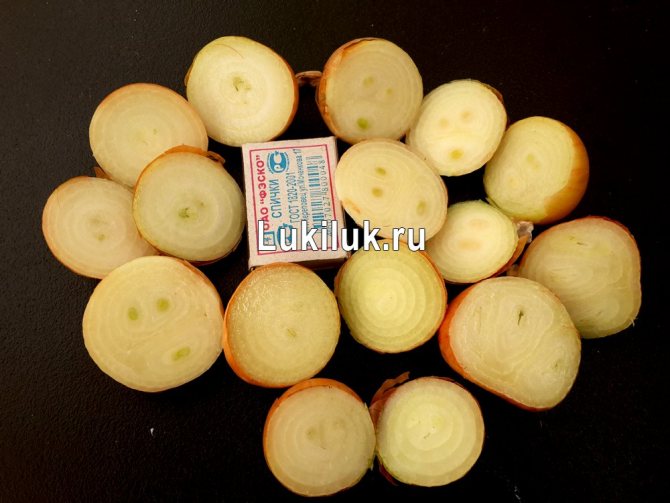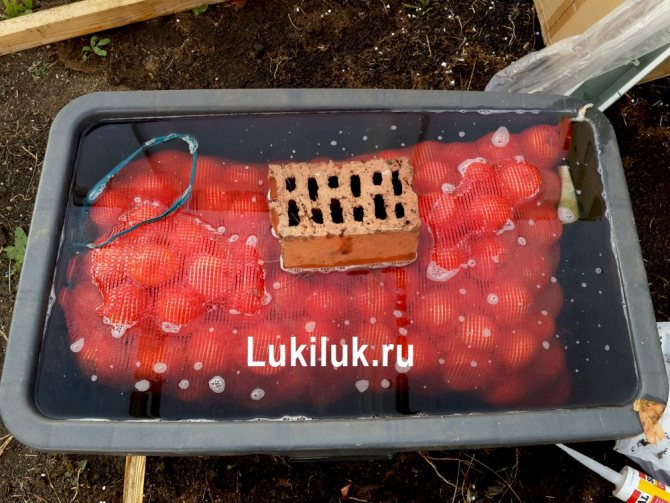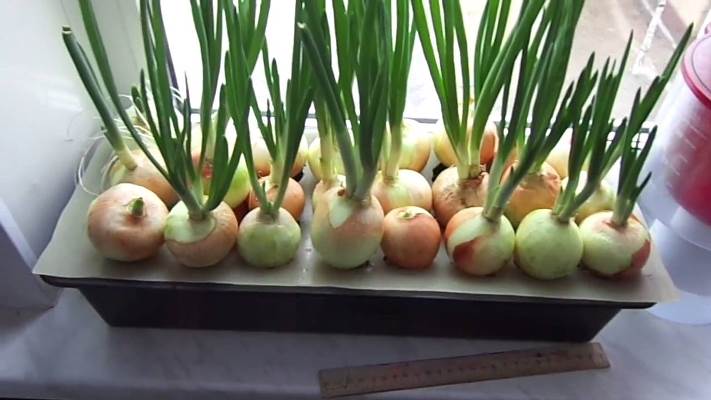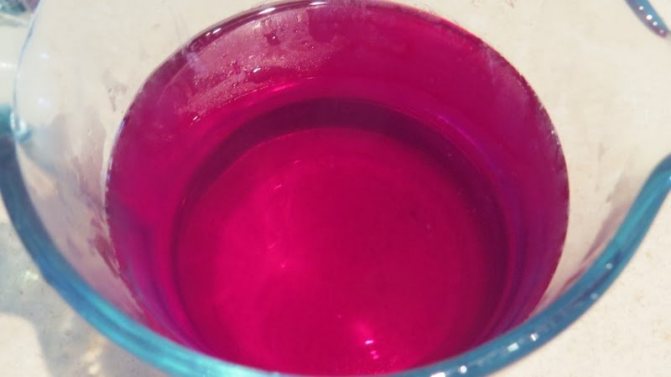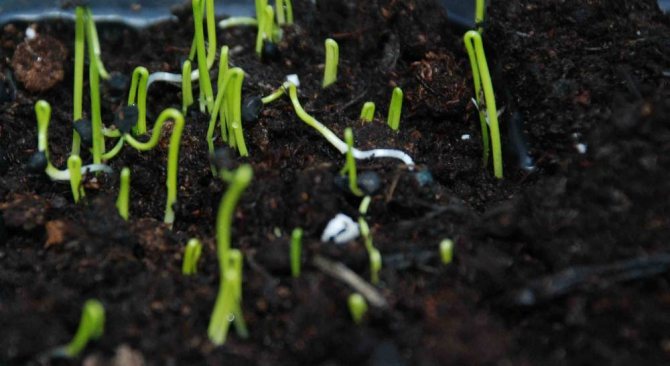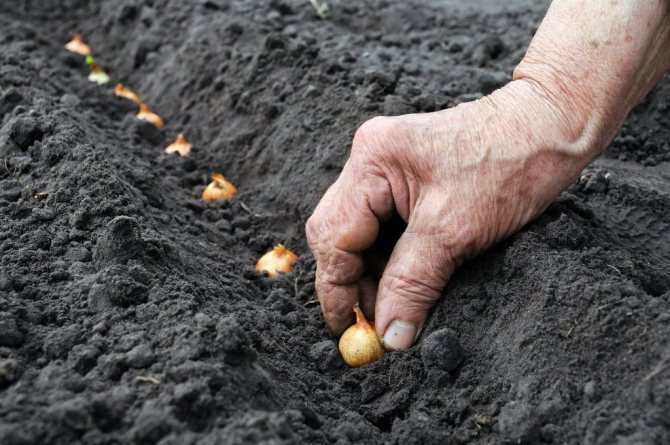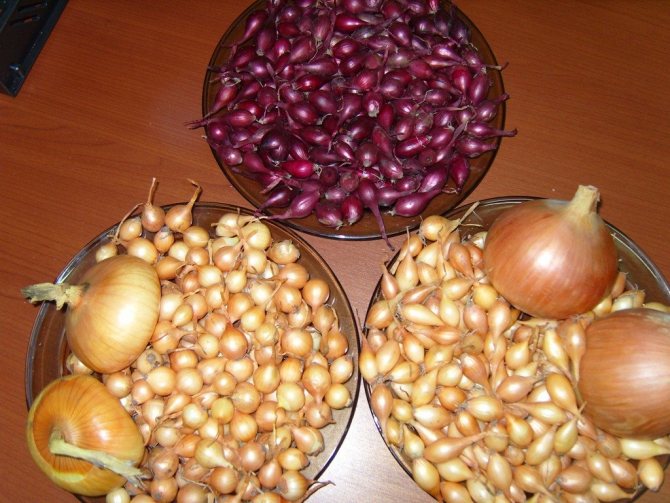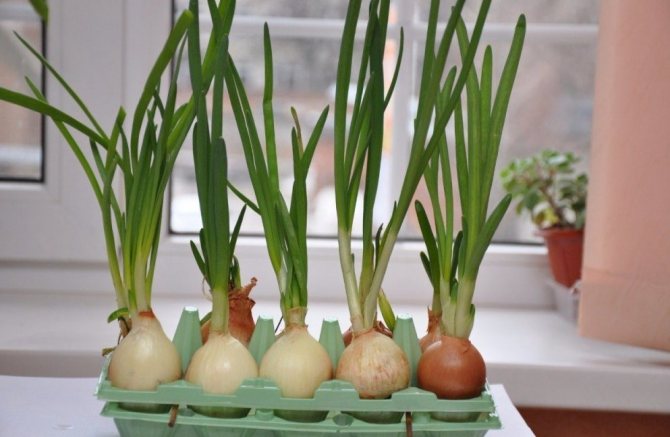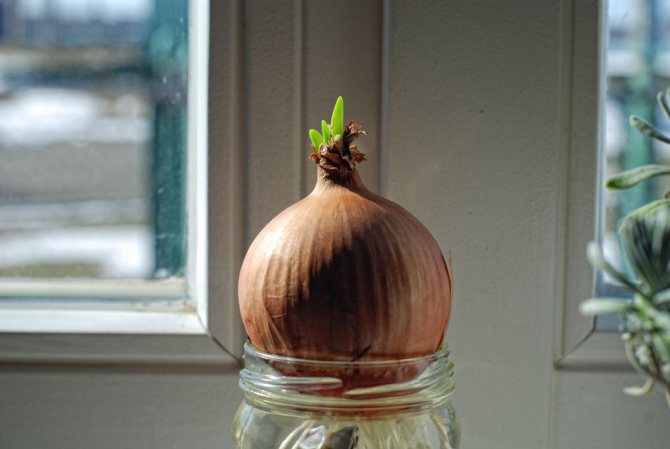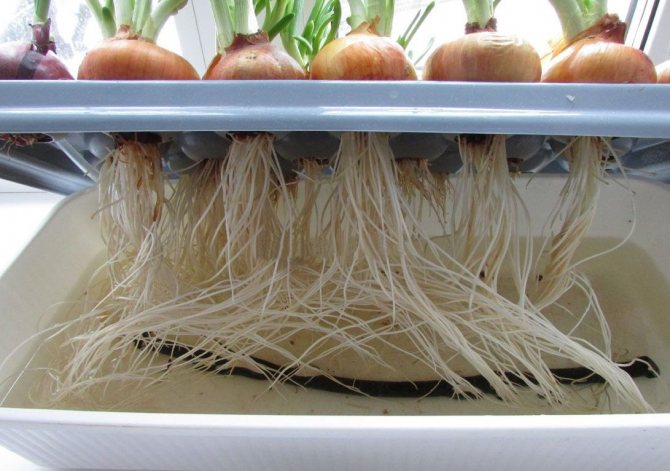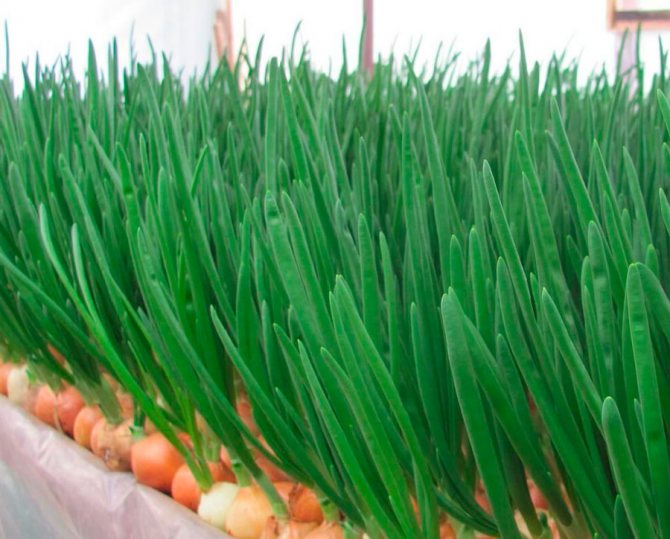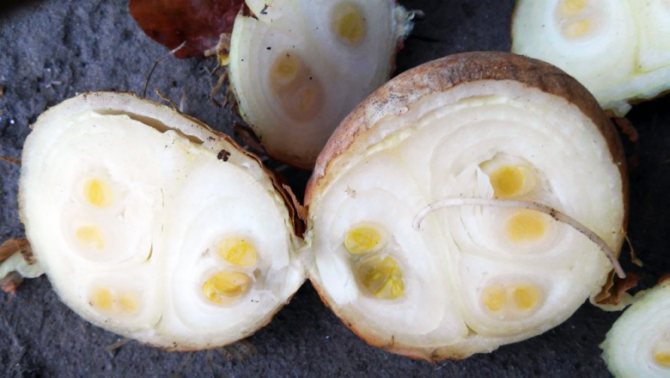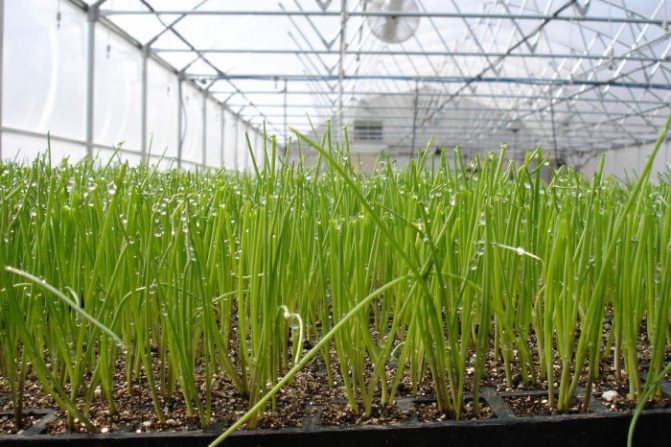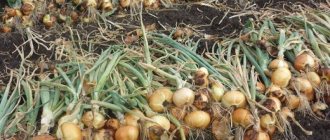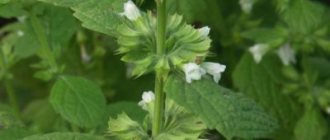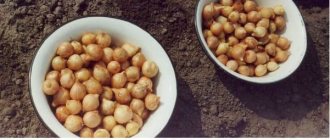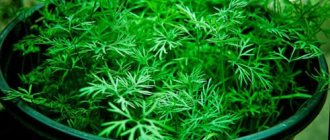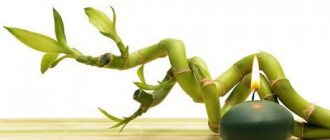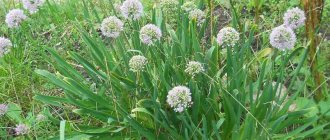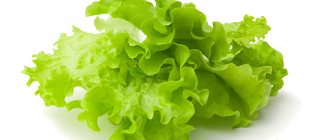Which varieties are suitable for growing on a feather at home?
It is important to choose the right type of bulbous culture, since depending on the type of onion has a different taste, and not every variety is grown for greens. What varieties are preferred:
- Batun, he is Tatar and winter. It is considered high-yielding, it can be annual and perennial. The peculiarity is that there are no bulbs, therefore it is planted mainly in the soil.
- Schnitt has a narrow and delicate feathers, which differ in length up to 50 cm. A pleasant aroma remains during long-term storage.
- Multi-tiered the variety withstands cool temperatures, due to which it grows well on windowsills in winter. Practically does not need care.
- Leek - a common variant with garlic feathers (in shape). Does not have bulbs.
- Shallot - juicy and unpretentious onions with high yields. Unpretentious enough to care for.
- Slime - similar to garlic, with a spicy pungent odor. Cultivated in a cool room, grows quickly.
- Parade - has excellent taste and good green mass.
- Onion onions are most often used by housewives for forcing feathers. Rotten heads can be used.
- Rostov it is distinguished by increased resistance to diseases of the fungal type, gives an excellent yield.
- Black Prince - multi-primordial, due to which one bulb produces many feathers.
- Amber not afraid of diseases, differs in dense greenery.
- Bessonovsky - short feathers of dense structure, average yield.
Preparing the bulbs for planting
Planting material must meet the following characteristics:
- diameter - 3–6 cm, weight 30–60 g (small specimens produce thin leaves-feathers);
- bulbs should not have any damage and signs of disease, be dry and ripe;
- sprouted and non-sprouted heads are planted separately.
Important! Onions should not be treated with special preparations that kill the growth point. Such onions will not sprout and will rot when distilled.
To get the most out of it, before forcing, the planting material must be properly processed and prepared:
- Cut off the tail of the selected bulb (size 3-5 cm) with a pruning shears, cut off the larger bulbs by a third. Cut off the feathers and roots for uniform and simultaneous growth of greenery.
- Prepared turnips are soaked in warm water (+ 45 ... + 50 ° С) for 24 hours. This provides disinfection and growth stimulation. You can add a solution of potassium permanganate or fungicide "Maxim Dachnik" to the water, the protective effect of which is longer than that of potassium permanganate, and the entire period of crop growth is valid.

Preparatory activities
Planting an onion on a feather is a matter that requires preparation of the site, soil, planting material, containers. The term of seedling formation, productivity, taste depends on this.
How to choose a seat?
Often, in apartments, onions are planted in containers, placed on the windowsill. This is necessary to provide the plant with light. If you have purchased a cold-resistant variety, you can place it on a loggia or window on the north side. But the best option for the bulk of bulbous crops is the south side, regardless of the method of cultivation.
Selection and preparation of seed
For forcing on a feather at home, bulbs and seeds are used. Accordingly, the latter are planted in the ground.
Features of choice:
- Seed material should be 2-4 years old.
- It is advisable to select the bulbs strong, resilient (diameter - at least 2 cm). Their size does not play a special role.
- The root of the onion must not be damaged.
- If the heads have begun to germinate, the germination time is accelerated.
- You can use sevki - small heads formed after planting seeds in the first year.
It is important to determine the germination of the planting material - the seeds are soaked in wet tissue (the more elements germinate, the better). The bulbs are subjected to trial distillation - one unit is planted in water (if sprouted, then the onion is ready for planting on a feather).
Seed preparation rules:
- select grains without damage;
- put them in clean warm water for a day, periodically changing the liquid;
- pay attention to the floating elements - these are empty flowers;
- disinfect - make a weak solution of manganese, hold the seeds for 60 minutes;
- wrap the planting material in a damp cloth for germination (this is optional, but desirable).
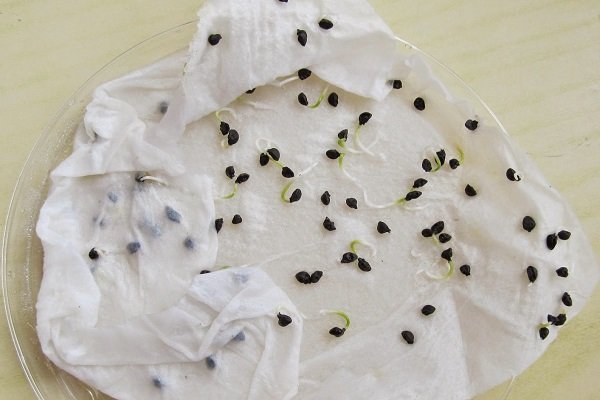

How to prepare the bulbs:
- disinfect the onion by immersing it in a potassium permanganate solution for an hour;
- pull out and rinse;
- put in a container with warm water, leave for a day or two in the room (depending on the size of the heads);
- after water procedures, remove the top layer of husk, cut off the top of the head by 1-1.5 cm;
- keep the bulbs in a solution with Epin, according to the instructions.
Soil and container preparation
The choice of container depends on the way the culture is grown - it can be a glass, bottle, box and other devices. Remember that onions do not like high humidity in the ground, as they are subject to putrefactive diseases. To prevent this, provide the containers with drainage - drill holes on the bottom, lay out a layer of stones.
The soil requires special preparation - it must be fertile and loose. Rules:
- if the soil is dense, add river sand, peat to it;
- disinfect the soil mixture with hot potassium permanganate;
- add compost or humus;
- before planting, dry the soil after treatment with antiseptics.
Growing conditions for greenery
Growing green onions indoors makes it possible to harvest all year round. Despite the fact that the greenery does not require special care, some requirements still have to be observed.
The main conditions for the growth of greenery:
- high-quality soil irrigation;
- comfortable air temperature;
- good lighting.
It should also be borne in mind that the room must be dry, light and not infected with mold.
Where can you grow green onions:
- In the basement or garage. Such rooms must be insulated (for example, with foam) and metal racks must be installed. In addition, the air in the room must be constantly circulated. The lighting should be bright. The optimum temperature is 22 degrees Celsius.
- In the greenhouse. Such a room can be made of a wooden frame, which must be covered with polyethylene film. In the warm season, the greenhouse does not need additional lighting. For green feathers to grow without problems, the natural temperature of the air and sunlight will be enough.
- On the balcony or windowsill. At home, green onions can be grown on a balcony or window. In summer, onions will grow naturally. With the arrival of cold weather, the balcony must be glazed and insulated. If the windows face north, it is advisable to create artificial lighting.


As a planting material, you can take not only land, but also sawdust, as well as sand. Alternatively, green onions can be grown in water. In a word, everyone can choose the option that is most convenient for him.
Landing technology
At home, it is customary to plant onions, placing them as close to each other as possible. The use of seeds assumes the duration of the formation of the feather part (2-4 months), the bulbs germinate in a few days.
Seeds
Seed material on the windowsill is planted extremely rarely, since the feathers do not appear soon, but they require special care. Landing technology:
- lay the drainage system on the bottom of the container;
- pour a layer of soil on top;
- make grooves to a depth of 1.5 cm;
- plant seeds in the holes (the distance between them is 2-5 cm);
- moisten the earth;
- cover with foil until sprouts appear;
- place in a warm, bright place.
As the seedlings grow, open the non-woven fabric daily for ventilation, water the seeds as the soil dries. The best soil is with the addition of vermicompost and coconut fiber.
Planting bulbs
Bulbs can be planted in different ways - in water, soil, sawdust - using a variety of containers:
- Landing in the water.
There is a classic option - pour water into a container (disposable glasses, jars, etc.), put onions and wait for the greens to appear. This technique is outdated and has drawbacks - rotting of the vegetable, the formation of unpleasant odors, the appearance of midges. Many people today use an improved technique to speed up feather growth and minimize problems.Step-by-step instruction:
- Cut off the top of the bulb, pierce the bottom (where the roots are) with a skewer.
Pour settled water at room temperature into a container, dissolve 2 tablets of activated carbon, lower the head so that only the root part is in the water.
- In a day, the roots will begin to grow. Now you need to drain the liquid a little so that it does not touch the bulb, but only affects the growing roots.
- After 12-16 days, you can harvest the greens.
- Landing in the ground.
This is the best option, eliminating unpleasant odors and decay. Prepare the soil, healthy bulbs, containers - container, pot, box. If you are using leeks, be sure to germinate them in water first for a week. Then proceed as follows:- soak onion roots in water for 2-3 hours;
pour 6-7 cm of soil into the container;
- make holes according to the size of the heads, retreating from each other by 2-3 cm;
- plant the vegetable to a depth of 2 cm (only the root will be in the ground);
- pour abundantly with settled or rain water;
- set the container in a dark place for 2-4 days, then transfer it to a lighted windowsill.
- Hydroponic.
This method is used when planting a large amount of bulbous culture. The mats are used, which can be bought in a specialized store. The principle of operation of hydroponics is based on the enrichment of oxygen and nutrients, due to which the green mass grows quickly.Feature - in the first days, the culture should be cool and shaded, after a week the system is transferred to the windowsill.
About the features of growing onions using hydroponics, see the following video:
- Growing in sawdust.
Instead of soil, the bulbs are placed in moistened sawdust. This makes it possible to avoid putrefactive diseases, bad odors, dirt. The only negative is that after collecting the greens, the sawdust needs to be changed.Planting process:
- disinfect sawdust with boiling water;
put them in a container;
- deepen the bulbs by 3 cm;
- pour water on;
- put the container on the sunny side of the apartment.
- Growing in a package.
Take a thick plastic bag, toilet paper, prepared heads. Instructions:- put paper on the bottom of the bag, moisten it;
arrange the bulbs tightly to each other;
- inflate the bag with air;
- tie tightly with a rope or elastic band;
- put in a dark place for the germination of the root system;
- expose to light after 3 days;
- it is forbidden to open the package before harvesting (about 10 days).
- Bottle method. This is a versatile vertical way of forcing the feather, saving space on the windowsill. What you need:
- 5 liter bottle (after food drinks only);
scissors / knife;
- onion;
- priming;
- expanded clay stones.
About growing onions on a feather in water, see the following video:
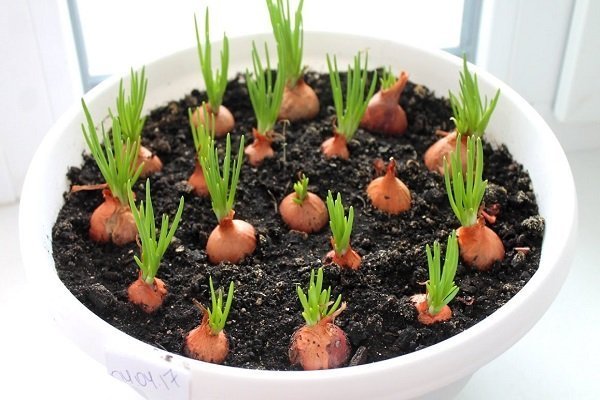

Feathers are harvested after 10-15 days. To prevent decay during watering, hydrogen peroxide is added to the water (10 ml per 1 liter).
For information on how to plant onions in sawdust at home, see the following video:
For information on how to grow onions in a bag, see the following video:
Tank preparation:
- cut off the neck;
- cut holes along the lower perimeter (the size depends on the diameter of the vegetable, the amount depends on the number of root crops);
- make the rest of the holes in a checkerboard pattern;
- sand the edges of the holes with sandpaper or a soldering iron;
- pierce the bottom with an awl to create a drainage system.
Planting process:
- place stones in one layer at the bottom of the bottle;
- pour a little substrate from soil, peat and humus on top;
- compact the soil;
- put the prepared heads into the holes (horizontally), pouring in the earth;
- place the top bulbs vertically;
- pour with water.
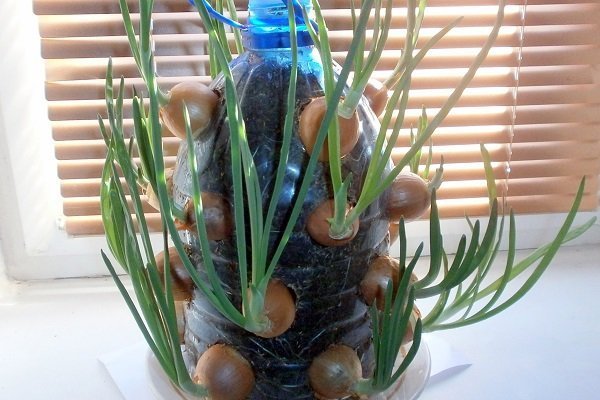

Selection and preparation of containers and soil
The choice of container depends on the method used for growing onions on a feather on a windowsill.
You can use pots and jars to grow onions in water. Even a glass of water will do. It is important to choose the width of the container neck so that the turnip does not fall into it. It should only be in the water with its lower part, otherwise the head may rot.
In addition to glass containers, plastic containers are used to store food. To do this, you need to cut out a thick sheet of paper or cardboard that is suitable in size and make holes in it. Water is poured into the container, and turnips are placed in the holes.
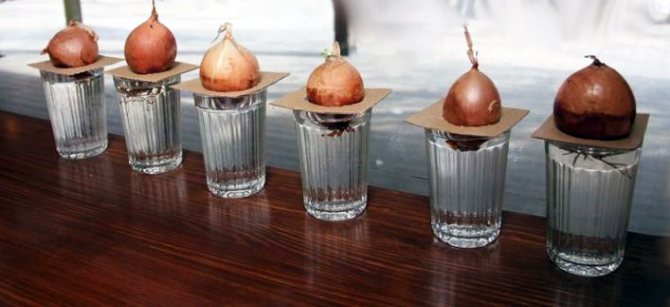

Using cardboard to reduce the diameter of the holes
For growing onions on a windowsill in the ground, boxes and containers with a height of no more than 10 cm are suitable. They must be filled with loose soil with drainage. The acidity of the soil should be PH 6-7. In the summer, you can take the land from the garden plot, and in the winter you can buy a suitable soil in the store.
Onion care at home
In order for the onion to produce a lot of greenery, it is necessary to provide it with favorable conditions. Regardless of the planting method, adhere to the following maintenance rules:
- lighting should be present for 10-12 hours, but there are no special requirements;
- temperature regime: air temperature - from +18 to + 22 ° С, soil or water - from +12 to + 25 ° С;
- the room must be ventilated, thereby reducing the risk of bulb rotting;
- watering the soil and adding water is carried out with warm settled water or rainwater (it is forbidden to use the tap water that was collected before the procedure).
When grown in soil
When growing onions on a feather in the soil, more sunlight is needed, so the container should be on the sunny south side. How to care for your culture:
- Move to fresh air daily or open windows. This should be done starting from the moment when the feathers reach 3-4 cm in length.
- Top dressing is usually not done, but experienced gardeners recommend adding potassium chloride, superphosphate, ammonium nitrate at the initial stages of green growth (4-5 cm), in accordance with the instructions for use. Further, when the greens can be cut, no fertilizers are used.
- Water the bulbs 1-2 times a week. If there are heating devices nearby that dry out the air, the frequency of humidification is increased.
- If the bulbs are not planted too close together, periodically loosen the soil.
- Water the greens 1-2 times a week, especially when the room temperature is high.
To harvest continuously, plant the bulbs in 2-3 containers with a difference in planting time of 2-3 weeks.
When grown in water
If the bulbs are grown in water, you will have to constantly maintain the same liquid level in the containers. The water should be changed as an unpleasant odor develops - about 1 time per week. For this, water at room temperature is used, which must be settled.
When grown in a bottle
In bottles, bulbous crops are planted in the ground, so they are cared for in the same way as when planting in boxes / containers. The only difference is watering, since the soil in bottles dries out faster, so you need to moisten it more often.
Sprouting green onions from seeds
This method is more time consuming, but some gardeners use this method.
The variety of seeds and their quality affects the speed of emergence of the first shoots and the amount of greenery cut.
The first step is to prepare nigella for planting work: disinfect and divide into groups by size. Then we soak the material laid out on several layers of bandage in a solution of sulfamide with water for half an hour. After rinsing with water, we additionally soak in a biostimulant solution for a day. The most popular brands in our country are Epin and Tsikron. They provoke the root system to develop better, which contributes to the rapid growth of the plant. Then again washed with water and placed in a dark, cool place. Gauze with seeds is kept moist all the time: watered periodically, but not abundantly. In this state, we keep the nigella until the white roots break through.
The prepared seeds are planted in special containers, which can be used as boxes and containers. Nigella is placed in the prepared soil at regular intervals. The material is so small that it is practically invisible. To simplify the work, it is mixed with chalk or talcum powder and poured into the holes made.
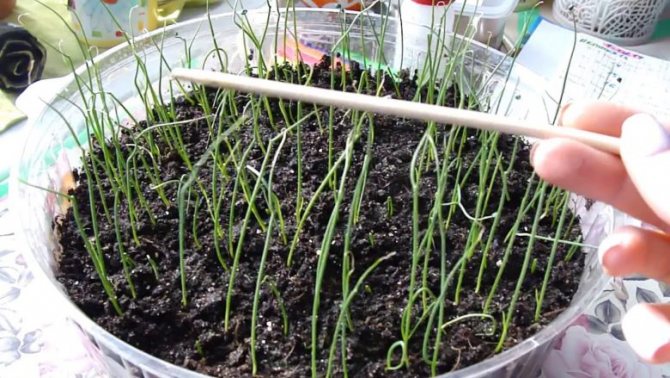

Onions on a windowsill from seeds
At the end of the work, the box is covered with foil to create a greenhouse effect. When sprouts appear, the film is removed. Plants are moistened by spraying 2-3 times a week.
Useful Tips
There are many tricks and tricks in growing onions for feathers, thanks to which you can get a lot of greenery and get rid of possible problems. Important recommendations:
- Egg trays can replace expensive hydroponics. To do this, take 1 plastic tray, dividing it in half. The lid will act as a pallet, and the cell will act as an upper tier. In each cell, cut off the bottom, place the bulbs in the holes. Pour water into the pallet, put the upper tier, placing wooden sticks between the two elements. This is necessary so that only the roots are in the water, and not the bulbs.
- In whatever you grow bulbous feathers, be sure to substitute trays under the containers and containers for water to drain after watering.
- Onions love light - without it, the feathers become light, yellow and lethargic. Therefore, in winter, it is necessary to provide the "beds" with additional light - put a phytolamp, fluorescent installation and the like.
- If it is too hot in the apartment, the onion stops the growth of green mass. In these cases, you need to wrap the container with ordinary foil, which will protect the heads from overheating.
- In the soil taken from the street, insects and larvae of pests can remain, which, under favorable conditions, actively reproduce. To prevent this, do not abandon the boiling water disinfection procedure. The earth can be roasted in the oven for 10-15 minutes.
- Try to pick up mother bulbs for forcing greens that yield 2-3 times more feathers.
Growing bulbs for feathers, regardless of the method, you can delight your family with fresh greens all year round. The main thing is to decide on the planting method, strictly follow the requirements of agricultural technology and do not forget to harvest.
0
Dates for planting onions on greens
The timing of forcing green onions must be taken into account depending on the region of residence. If planting in open ground is planned, then the soil should warm up to 7-10 ° C. When buying planting material, you need to pay attention to the following points:
- what temperature the onion can withstand, that is, its frost resistance;
- a tendency to disease;
- yield from 1 sq.m.
If you want to get early green onions on a feather from seeds, then the winter growing method is suitable. The optimal timing is the first week of autumn frosts. In Central Russia, this is the end of September. The proven podzimny onion variety - Parade. Before planting, the garden must be prepared, that is, dug up and fertilized, and the seeds must be checked for germination by soaking.
For spring plantings, sevok is most often used. A head from 1.5 to 5 cm in diameter is selected. In open ground, seedlings are planted in late April-early May, when frosts are already short-lived, and the soil is stably warmed up to 5 ° C. In Siberian regions, planting begins 1.5-2 weeks later.
In the summer, sowing is done several times per season. In July, you can plant perennial onion varieties on greens, which will sprout at the end of March. But the ground should be mulched before the cold weather to prevent plants from freezing.


Onion in the open field
The August plantings will bring the harvest in mid-September. So that the greens have time to ripen before the cold weather, it is worth choosing early ripening varieties. It is advisable to plant the crop in a greenhouse or in containers to bring them to a warm place if severe frosts begin.

